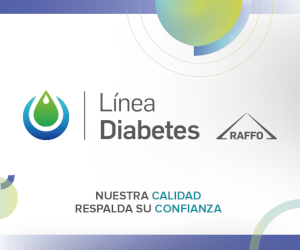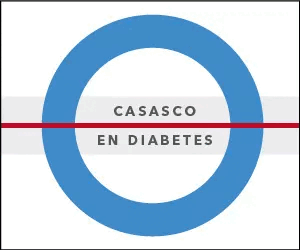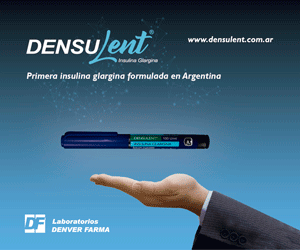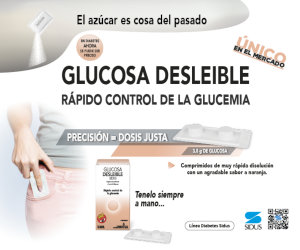Symposium: New horizons in the treatment of type 1 diabetes mellitus. Continuous glycemic monitoring and glycemic control online
DOI:
https://doi.org/10.47196/diab.v55i3Sup.507Keywords:
diabetes, glycemic controlAbstract
The tools to assess the degree of glycemic control were modified lately. Glycosylated Hemoglobin (HbA1c), the gold standard, reflects the glycemic control of the last 3 months retrospectively, without expressing glycemic variability. It can be modified in the presence of hemoglobinopathies and/or alterations of erythropoiesis, inducing inappropriate and late therapeutic decisions.
Self-blood glucose monitoring (SBGM) provides immediate and prospective information, but has little glycemic data to generate representative averages and standard deviations. It does not detect trends and has limitations to obtain nocturnal data or during physical activity. It is invasive and often rejected.
On the contrary, continuous glucose monitoring (CGM), allows to measure glucose instantly, shows your trends and variability continuously, incorporating new control metrics. The CGM would be indicated in adults, adolescents and children (> 4 years for FreeStyle Libre and > 2 years for Dexcom), with diabetes mellitus type 1 (DM1) without adequate glycemic control or with adequate control presenting mild hypoglycemia/moderated. It is also indicated in pregnant patients with DM1 or with type 2 diabetes mellitus (DM2). For DM2, except under intensified insulin therapeutics (IIT), the evidence at the moment is scarce, although recent studies show its effectiveness in these patients.
The ambulatory glucose profile (AGP) analyzes the patterns of glycemic control during sleep, prolonged fasting, physical activity and intercurrences, expressing them as curves with their standard deviations during periods of hours (8 to 24 hours) or days (7, 14, 30 and 90 days). The AGP contains the following metrics: percentage time in range (70-180 mg/dl=TIR), percentage time above range (>180 mg/dl TAR), percentage time below range or hypoglycemia (<70 mg/dl=TBR) and coefficient of variation (%CV). It is suggested to achieve a TIR >70% of the day, a TAR > 180 mg/dl < 25% of the day and a TBR < 70 mg/dl at < 5% of the day. In labile patients, a TIR only 50% of the day. In pregnant women with DM1 a TIR of 63-140 mg/dl in > 70% of the day.
The continuous information allows immediate decisions to be taken by ingesting carbohydrates or by applying insulin. CGM with IIT or continuous subcutaneous insulin infusion (CSII), is a very useful and complementary tool for the treatment of DM1 and DM2 in insulin therapy. Its use was associated with significant decreases in HbA1c, decreased glycemic variability, reduction of total and nocturnal hypoglycemia and improvement of the quality of life in these patients. Finally a very important advantage of this tool is the chance to achieve all the information on line.
References
I. Bergenstal RM, et al. Glycemic variability and diabetes complications: Does it matter? Simply put, there are better glycemic narkers! Diabetes Care 2015; 38:1615-1621.
II. Kovatchev B, et al. Glucose variability: timing, risk analysis, and relationship to hypoglycemia in dabetes. Diabetes Care 2016 Apr; 39(4): 502-510.
III. Agiostratidou G, et al. Standardizing clinically meaningful outcome measures beyond HbA1c for type 1 diabetes: A Consensus Report of the American Association of Clinical Endocrinologists, the American Association of Diabetes Educators, the American Diabetes Association, the Endocrine Society, JDRF International, The Leona M. and Harry B. Helmsley Charitable Trust, the Pediatric Endocrine Society, and the T1D Exchange. Diabetes Care 2017; 40:1622-1630.
IV. Danne T, et al. International Consensus on use of continuous glucose monitoring. Diabetes Care 2017; 40:1631-1640.
V. Battelino T, et al. Clinical targets for continuous glucose monitoring data interpretation: recommendations from the International Consensus on Time in Range. Diabetes Care (2019);42:1593-1603.
VI. Siegelaar SE, et al. Glucose variability. Does it matter? Endocrine Reviews 2010; 31(2):171-182.
Downloads
Published
How to Cite
Issue
Section
License
Copyright (c) 2021 on behalf of the authors. Reproduction rights: Argentine Diabetes Society.

This work is licensed under a Creative Commons Attribution-NonCommercial-NoDerivatives 4.0 International License.
Dirección Nacional de Derecho de Autor, Exp. N° 5.333.129. Instituto Nacional de la Propiedad Industrial, Marca «Revista de la Sociedad Argentina de Diabetes - Asociación Civil» N° de concesión 2.605.405 y N° de disposición 1.404/13.
La Revista de la SAD está licenciada bajo Licencia Creative Commons Atribución – No Comercial – Sin Obra Derivada 4.0 Internacional.
Por otra parte, la Revista SAD permite que los autores mantengan los derechos de autor sin restricciones.







































